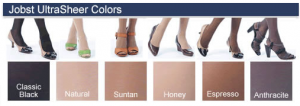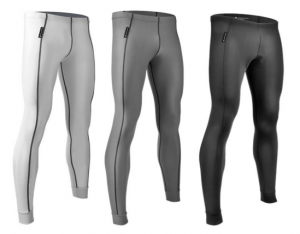Many doctors advise their dysautonomia patients to try medical compression stockings, but busy doctors often don’t have the time to explain how to get the stockings, where to get them, and how they can help. We’ve put together a quick reference guide to answer common questions dysautonomia patients have about medical compression stockings.
Symptoms They Can Help With
Medical compression stockings can help prevent or minimize dysautonomia symptoms such as lightheadedness, fainting, low blood pressure, tachycardia, fatigue, “brain fog” and muscle pain caused by blood pooling in the legs. They may also give you more endurance to tolerate longer amounts of upright activity before your dysautonomia symptoms set in. Everyone is different, so there is no guarantee they will help you, but if your doctor has recommended compression stockings, it’s definitely worth it to try them out.
Getting the Right Compression Level
Most dysautonomia experts recommend 20-30mmHg or 30-40mmHg waist-high stockings. Lower levels of compression or stockings that aren’t waist high will give you less benefit. However, it’s more important that you find something comfortable that you are willing to wear everyday, that improves your symptoms.
Knee-High vs. Thigh-High vs. Waist-High Stockings
 Most dysautonomia experts recommend waist-high stockings because blood pooling in dysautonomia patients can occur in the entire lower half of the body, including thighs and the abdominal area. If you wear knee-high stockings and have blood pooling in your thigh area, you may notice a swelling at your knee, above the top of the knee-high. Same thing with the thigh-highs. Medical compression stockings are super tight and unless you are very thin, the thigh-highs will probably create a not-so-glamorous thigh bulge above the top of the stocking. Waist-high stockings will help prevent the blood pooling in your abdominal area.
Most dysautonomia experts recommend waist-high stockings because blood pooling in dysautonomia patients can occur in the entire lower half of the body, including thighs and the abdominal area. If you wear knee-high stockings and have blood pooling in your thigh area, you may notice a swelling at your knee, above the top of the knee-high. Same thing with the thigh-highs. Medical compression stockings are super tight and unless you are very thin, the thigh-highs will probably create a not-so-glamorous thigh bulge above the top of the stocking. Waist-high stockings will help prevent the blood pooling in your abdominal area.
If you find waist-high stockings uncomfortable, there’s no reason not to try the thigh-highs or knee-highs, but they won’t be as effective as the waist-highs. Some compression is better than none if your doctor has recommended compression stockings.
 Open Toe vs. Closed Toe
Open Toe vs. Closed Toe
Some brands of waist-high medical compression stockings come with open or closed toes. Open toes are good for summer flip flops, peep toe heels and may be more comfortable for people with sensory neuropathy in their feet. Open-toe stockings are also a little easier to get on and off. But otherwise, they are the same.
Opaque vs. Sheer
Sheer stockings may be a better option for women who require formal attire for work or when you’re headed out to a party in a fancy dress, but they tend to be scratchier than the more opaque stockings. Sheer stockings may also tear faster than the thicker opaque stockings. Opaque stockings tend to be softer and have a more cottony feel to them. Opaque stockings tend to breath better too.
Latex
Most brands are latex free, but if you have a latex allergy, be sure to ask before you buy the stockings. Sometimes latex is used in the elastic bands at the top of the stockings.
Cost and Insurance Coverage
Stockings range in price from $20 at the drug store to $150 for high-end prescription stockings. Contact your insurance company to see if they cover medical compression stockings with a prescription from your doctor. If they do, they may require you to use certain medical supply companies to order them. If not, you can get them online, but you may want to call a local medical supply store to get a proper fitting for your first pair, and anytime you lose or gain significant weight. In our experience, the cheaper drug store stockings don’t have great compression and they don’t last very long.
Getting the Right Fit
Medical grade compression stockings usually measure your ankle circumference, your calf circumference and the distance between your heel and knee. Ankle and calf measurements should be taken first thing in the morning, as your legs will swell the longer you are upright (this happens to healthy people too). Sizing differs between brands. If you can get a professional fitting done, this may help you get the most of your stockings. Some medical supply stores can do this.
Looking Good While Feeling Good
Your grandma’s compression stockings may have been hospital white or an icky shade of greyish beige. Lucky for you, compression stockings come in great colors and prints now, and even sheers that look like regular pantyhose. There are also compression leggings in fun patterns and prints. For those of you who don’t want hot pink or tie-dyed legs, there are nude, tan, brown and black options too. Some of the black stockings look like fitted running pants or leggings.


How Do You Get These Things On?
First rule of donning compression stockings – do not even think about trying to put them on when you first get out of the shower! Damp skin or lotion on your skin will make it pretty much impossible to get them on. Lotion can also damage the fibers in your stockings, so you may want to skip it when you plan to wear your stockings. Check the care instructions that came with your stockings to be sure.
Once your skin is nice and dry, you are ready to put them on. Sit on the edge of your bed and put your foot up on a chair, the wall or a dresser. Pull them on one leg at at time. Lay down if you have to while rolling them up your leg. Take a break if needed – this can be tricky when you are first getting used to them. Putting a little bit of water on your hands can help you get some extra grip to pull the stocking up.
If you are using open-toe stockings, most stocking companies will send you a heel slipper to help you get the stockings on. It’s a piece of silky fabric or slippery paper that you can use to slide the stocking over your heels, and then pull the slipper out through the toe opening once the stockings are on.
When To Wear Them?
Compression stockings work best when you put them on the in morning, before you are up and walking around. This will help prevent blood pooling. If you wait until later in the day to put them on, after you have been sitting or standing up for a while, your blood will have already started to pool in your legs – this can make it ever harder to get the stockings on, and makes them less effective in helping with your symptoms.
You can wear them all day, but you shouldn’t sleep in them. If you have ever been so tired you fell asleep with your stockings on, you may have awakened in the middle of the night to completely numb tingling cold legs. Not fun!
Can I Wear Them In The Heat?
Some dysautonomia patients are very sensitive to the heat. Heat causes vasodilation, so wearing your stockings in the heat is probably the best time to wear them. Finding a brand with breathable comfortable fabric is the key for summer stockings. Open-toe stockings are great for the summer because you can wear flip flops or sandals, and airing out your toes can help keep your cool.
Can I Wear Them In The Pool?
Most stocking manufacturers would advise against this because the chlorine or salt water will damage the elastic fabric over time. But if you are able to keep a spare pair for “pool stockings,” they are fine to swim in. You probably don’t need the compression while swimming, because water actually compresses your legs much more than the stockings do, but some dysautonomia patients experience lightheadedness as soon as they get out of the pool. It may be that we are noticing it more because we have just enjoyed the benefit of water compression. To bad we can’t live in the pool!
Tips for Women
Wearing compression stockings everyday, especially in the summer heat, might leave some women more prone to developing yeast infections, so consider cutting a small hole in the crotch of the stockings to promote air circulation. Stay inside the ‘control top’ seam so you don’t get a big tear in the stockings. This will void any warranty your stockings may come with, so try it on an older/cheaper pair first.
Other Compression Garments
 If you are not up for medical compression stockings, there are other compression garments available, like compression socks, leggings, arm compression sleeves and sports recovery compression suits. However, it’s not proven whether these garments provide enough compression to make a difference in dysautonomia symptoms. Like many dysautonomia treatments, it may take a little experimenting to figure out what
If you are not up for medical compression stockings, there are other compression garments available, like compression socks, leggings, arm compression sleeves and sports recovery compression suits. However, it’s not proven whether these garments provide enough compression to make a difference in dysautonomia symptoms. Like many dysautonomia treatments, it may take a little experimenting to figure out what
works best for you.
Share Your Experiences
 Do you have fabulous funky compression stockings? We’d love to see them! Send compression stocking photos to info@dysautonomiainternational.org. Let us know where you purchased them and what compression strength they are, in case other patients would like to buy them.
Do you have fabulous funky compression stockings? We’d love to see them! Send compression stocking photos to info@dysautonomiainternational.org. Let us know where you purchased them and what compression strength they are, in case other patients would like to buy them.